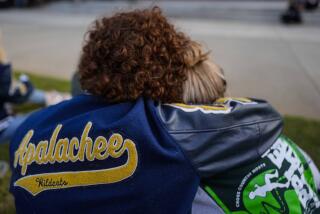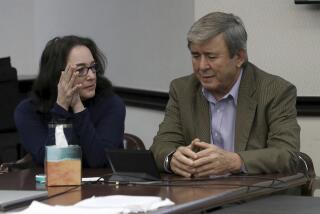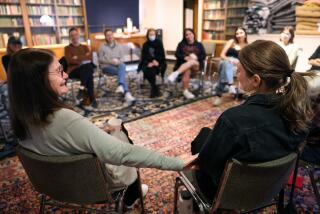Counseling Program Helps Teen-Agers Face Grief, Anger of Death
- Share via
A week after a teen-age boy committed suicide at a Canyon Country high school, a parent asked a school counselor how she could help her daughter vent the feelings she had about her classmate’s death.
The mother, whose own brother had killed himself years before, said her daughter showed no signs of grief. “And that worries me,” she told the counselor. “And it’s not just this incident. It’s all of them.”
Since 1985, five students from Canyon High School have died--two in auto accidents, three by their own hand. In response, school officials have provided special counseling for students and a program on suicide and grief for their parents.
Last week, all 2,150 Canyon High students were asked to write essays expressing their feelings about death and the suicide of high school junior Jesse de Jesus 11 days ago.
De Jesus shot himself in the forehead with a handgun while standing in a remote athletic field between the high school campus and North Oaks Park on Jan. 13. A student in an archery class discovered the body, but no one saw the 16-year-old boy pull the trigger, Principal William White said.
Mortally wounded, De Jesus was taken to Henry Mayo Newhall Memorial Hospital in Valencia, where doctors declared him brain-dead. Life-support equipment kept him alive until his heart, lungs, liver and kidneys could be removed for transplant.
Julie Tate, a talented athlete who lettered in volleyball, soccer and softball, had shot herself to death a year earlier. Josh Loveland, described as a typical high school boy, committed suicide the year before that. Both were 17.
In 1985, Canyon student Laura Strickland, 17, was killed when the car she was driving crashed and flipped over on a mountain road. A few months later, her one-time prom date, Joe Crawford, 18, also died in a car crash. Blood tests showed that both students had been drinking.
The five deaths have sparked confusion, depression, even anger in some of their classmates, said Linda Cunningham, a specialist in bereavement counseling with Kaiser Permanente hospital in Panorama City. Such reactions are typical, said Cunningham, who two years ago founded Teen-Age Grief, a nonprofit organization to help teen-agers cope with feelings of loss or confusion after a death.
Counselors and teachers trained by Cunningham offer six-week counseling programs at junior and senior high schools with Teen-Age Grief chapters in the Santa Clarita and San Fernando valleys.
At Canyon, where a chapter was started this winter, the six meetings each attracted seven to 15 students. The program ended the week De Jesus shot himself. Cunningham expects larger classes when the sessions begin again, sometime in the next few months.
A week after De Jesus’ suicide, Cunningham invited parents to a program in the school library to explain why some teen-agers are unable to cope with death. Teen-agers typically are independent, she explained, and might not reach out for support or affection. As a result, their feelings stay hidden, and their emotional scars heal with difficulty.
Evidence of Suppression
Several parents said their children appeared to be suppressing pain and confusion. Some of the children became unusually quiet, the parents said. One boy told his mother that the death did not bother him. She was not convinced.
Another woman told Cunningham that her son seemed to have changed since De Jesus’ death. She said the boy appeared distracted and had begun driving carelessly.
The mother acknowledged that she, too, is confused. The dead boy was a friend, she said. A few weeks before his suicide, De Jesus asked her if the rumor about the family’s buying a new home and moving from Canyon Country was true.
She said told him “yes,” and asked if he could be counted on to help with the move. “Yeah, sure,” she remembered his replying.
Several times, the woman said, she has asked herself if the brief conversation contributed to the boy’s suicide. Her son told her, “Mom, I had the same thought.”
As she did when other parents spoke, Cunningham told the woman that getting such feelings out into the open was healthy. “Let them see your tears,” she said. “Talk about your anger.” She advised the mother and son to keep talking. Cunningham suggested that those who are unable to talk so frankly put their feelings down on paper.
A day after the program for parents, a letter written by a 16-year-old girl after her brother hanged himself was read to all the students. The letter, included in materials provided by Teen-Age Grief, expressed rage, love, sadness and, most of all, confusion. The girl addressed it to her brother.
After hearing it, the students were asked to write their own letters. They could be addressed to anyone they wanted, or to no one at all. They could be long or short, finished or unfinished. The writings wouldn’t be graded; they didn’t even have to be turned in.
The aim, Cunningham said, was simply to force students to think about death. Writing would not make the grief disappear, but could get the healing process started.
A Sudden Silence
Once the assignment was given in Judy Monteleone’s 10th-grade English class, all clowning instantly stopped. The 25 students were suddenly silent.
“You’re writing the letter for you, not for anyone else,” Monteleone said as students pulled out pens and paper. Some of the teen-agers worked slowly; others scribbled. A few cried.
Several wrote about grandparents who had passed away. “Something really scares me and confuses me,” one girl wrote to her grandfather. “I never cried for you. When you died, I never ever cried.” The girl reminded him of her love and concluded, “I hope you can forgive me.”
Another student wrote to Jesse de Jesus.
“Jesse, I really didn’t know you well, we weren’t best friends but I did know and I do care,” the boy wrote. “We played football in the street near your house not too long before you killed yourself. By the way, I’m pretty pissed at you for that. . .
The boy recalled a sandlot football game. “You even fumbled the pass I threw,” he wrote.
“I feel mad at you. Look what you’ve done to your family, friends and yourself. Now, I’ll never be able to find out if you can really catch a pass. Too bad, for you I mean. I’m a caring person, and you’ll never get to let me care.”
More to Read
Sign up for Essential California
The most important California stories and recommendations in your inbox every morning.
You may occasionally receive promotional content from the Los Angeles Times.










